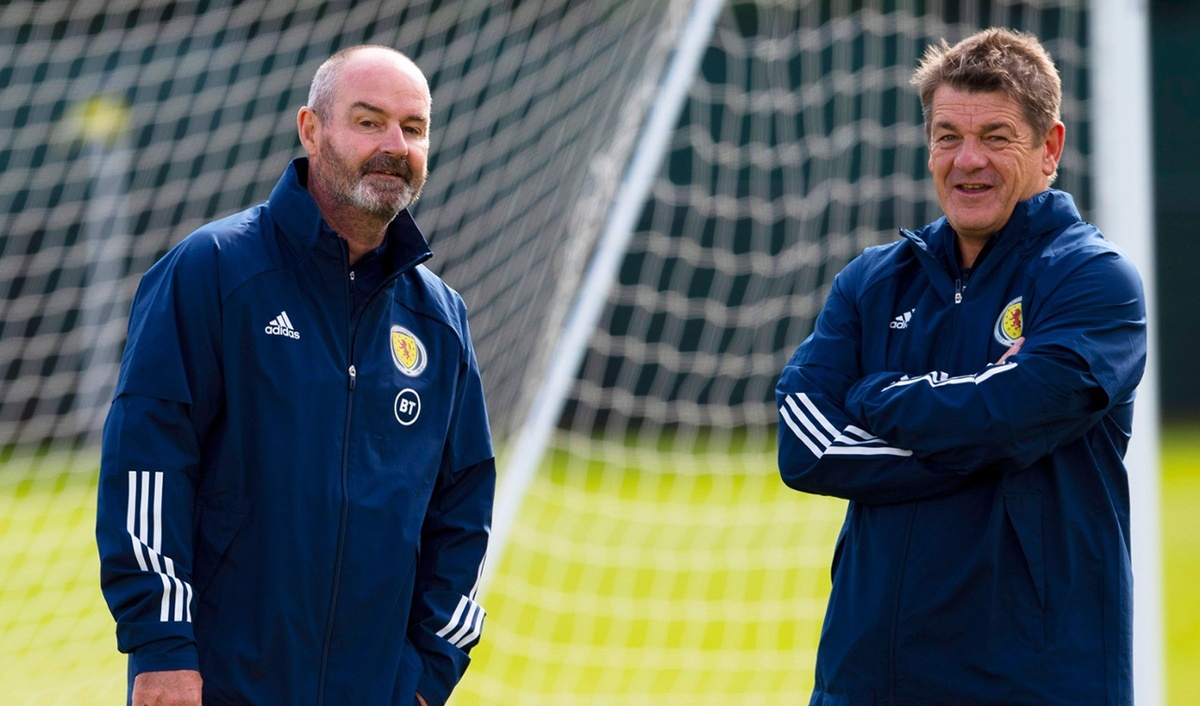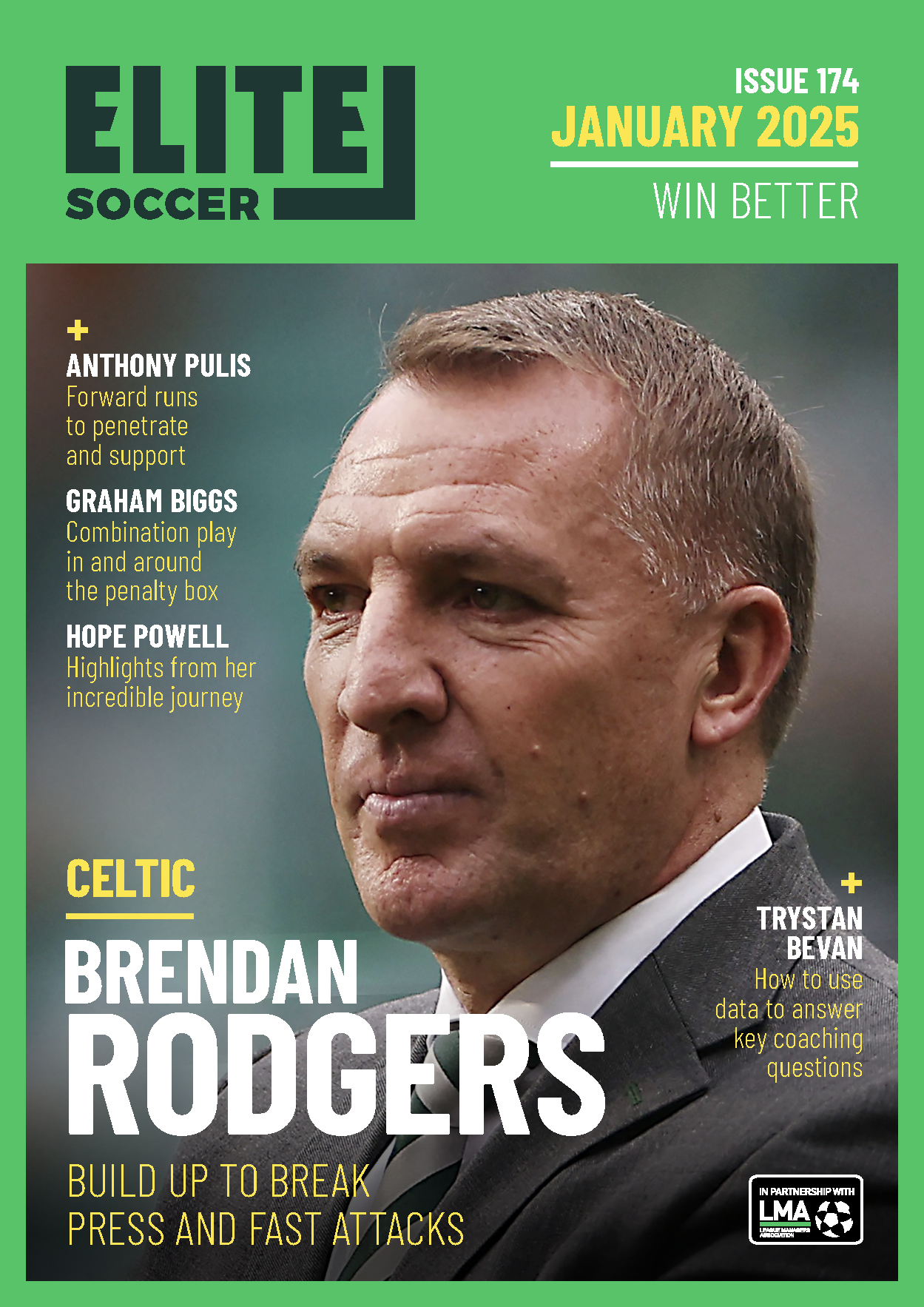You are viewing 1 of your 1 free articles
Attacking patterns of play
| Area | Full pitch |
| Equipment | Balls, bibs, cones, 10 mannequins, 1 full size goal |
| No. of Players | 20 players + 2 goalkeeper |
| Session Time | Each drill: 15 minutes |
This training session is all about building up play in the middle third in a 3-4-3 formation. It’s important at any level to give players several options going forward and then it’s up to them to execute what they see in front of them.
This session engages the players because it involves the whole squad playing in their appropriate positions, giving them a realistic understanding of their roles and responsibilities within the team. Players like to know their roles, as it takes away any grey areas.
Because with Scotland we are dealing with international footballers, their technique is usually sound, so this session is all about showing them what we expect from them and encouraging them to make the right decisions at the right time.
As the Scotland squad only gathers together for a short period of time during international breaks, it’s extremely important to bed down our principles and style of play when possible. This might be done on the training ground or in the lecture room.
“It’s important at any level to give players several options going forward and then it’s up to them to execute what they see”
BUILD UP COMBINATION PLAY
We set up on a full-size pitch with 10 mannequins positioned as shown. We’re using 20 outfield players and two goalkeepers. Players will double up in each position, although we are only showing one in each position in the diagram.
In this first drill, the back five and the front five work in separate groups to develop attacking combinations and patterns of play, as shown [1].
The back five work together with a defensive coach on their build up combinations. In the defensive half of the pitch, the session starts with the defending coach serving into the central centre back. The centre back then plays out around the back five, linking the ball back up with the defending coach through various combinations. All play is one and two touch, as this encourages the players to move the ball quickly from side to side.
At the same time, the front five work together with a forward coach on developing various attacking combinations from the middle third of the pitch. The coach starts play by serving into the midfielder and they combine with the attackers to create a scoring opportunity. The drill should finish with an attempt on goal.
We want to see the defenders moving the ball quickly, with one or two touches when possible. We also want to see them make good supporting runs and creating angles. We want to see the attacking players looking to play forward when possible, making penetrating forward runs both with and without the ball.
[1]
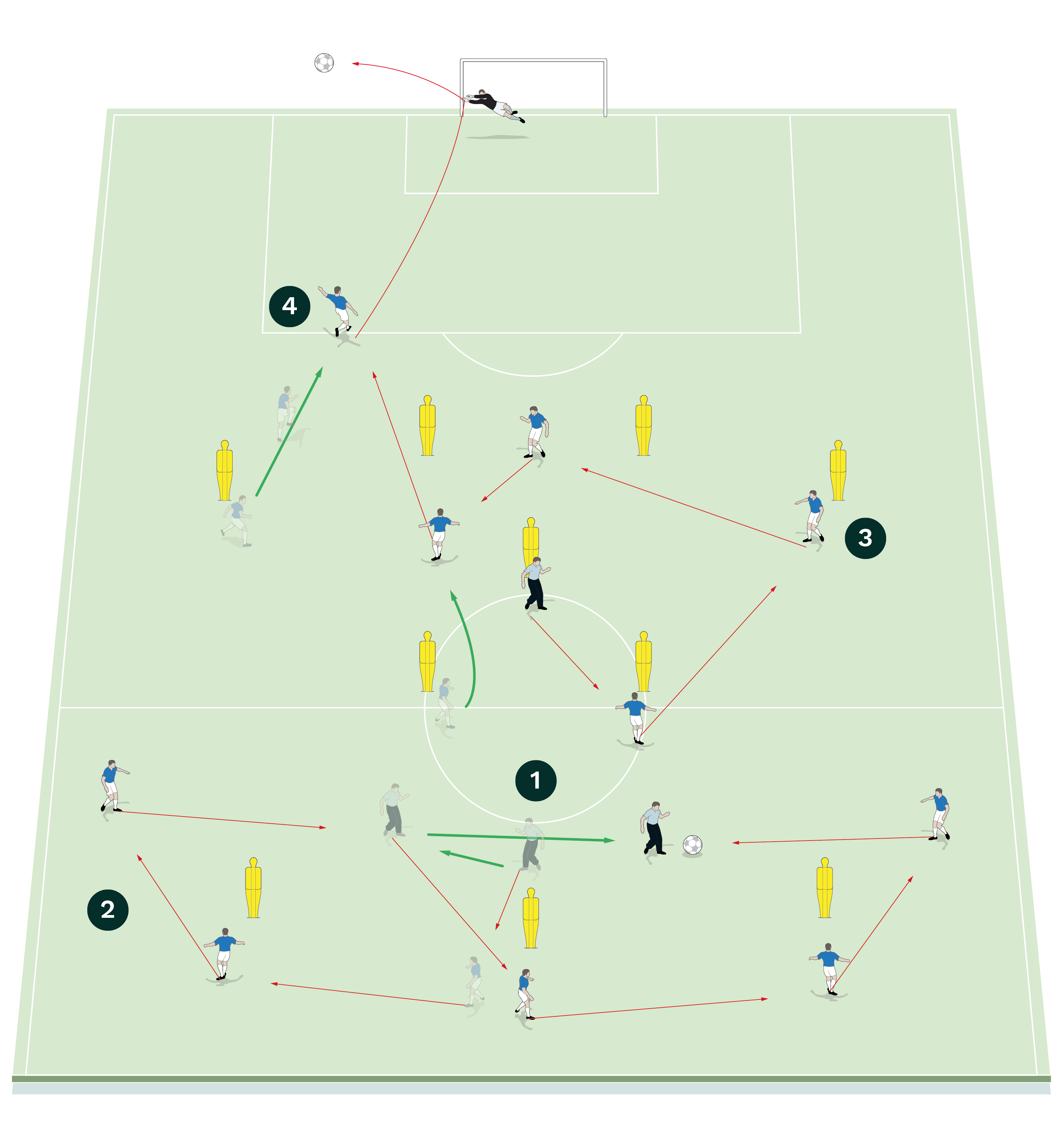
2. The back five work together on developing build-up combinations, passing the ball quickly with one or two touches
3. In the attacking half of the pitch, a coach starts play by passing to a midfielder, who combines with team mates to circulate the ball
4. The front five work together on quick attacking combinations from the middle third. The move should finish with an attempt on goal
ATTACKING PATTERN 1
[2]
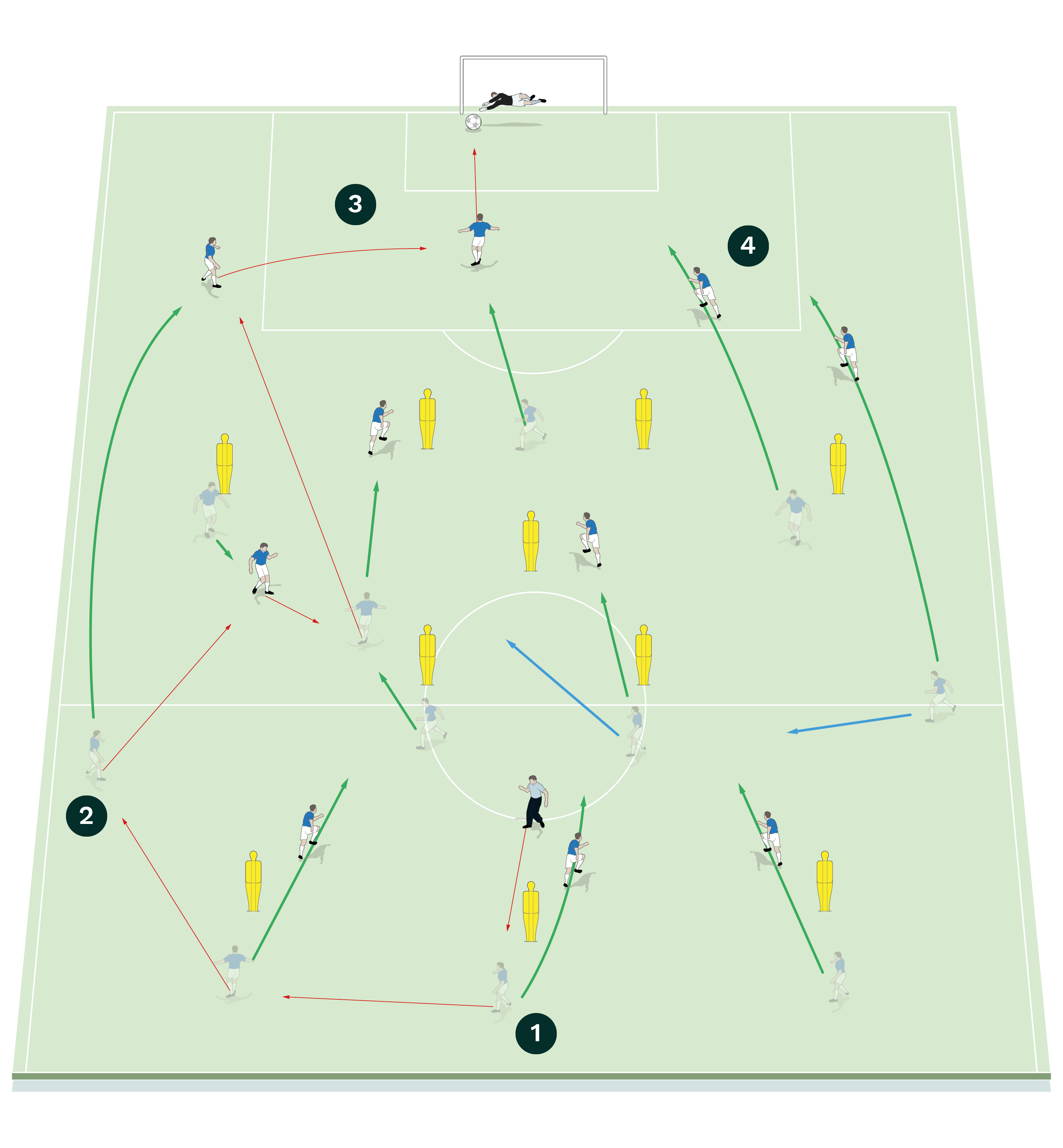
2. The players should use quick combination play and forward passing to build up play through the middle third
3. The forwards should arrive in the penalty area to attack the cross and finish the move with a shot on goal
4. Players should be prepared to make unselfish forward runs without the ball to get numbers in the penalty box
“We want to see players prepared to make unselfish forward runs without the ball to get numbers into the box”
Using the same set-up, we bring the combination play of the defensive and attacking groups together into one move. The drill starts with a pass from a coach, who serves the ball to the middle central defender. The central defender opens up and plays to the left centre back, who then plays it to the left wing back. The wing back turns and passes forward into the left-sided attacker, who sets it back to the left-sided central midfielder. He then plays the ball into the space behind the right back mannequin for the left wing back to cross into the box. The forwards should arrive in the penalty box to attack the cross and finish on goal, as shown [2].
We want to see the players having open body positions to receive the ball. Also, we want to see players playing forward when possible and, if this is not achievable, they should retain possession.
As the build-up play should end with a shot on goal, we want to see players prepared to make unselfish forward runs without the ball to get numbers in the box.
After running it as shown, we would then run the same drill going down the other side of the pitch.
ATTACKING PATTERN 2
Using the same set-up, we work on a variation of the build-up play. Again the drill starts with the coach serving the ball to the middle central defender, who opens up and plays to the left centre back. But this time,0 when the ball is passed to the left wing back, the wing back sets it back to the left centre back who passes forward to the left-sided attacker. The left-sided attacker sets it back to the left-sided central midfielder, who then plays the ball into the space behind the right back mannequin for the left wing back to cross into the penalty box, as shown [3].
We would then run this drill going down the other side of the pitch. The weight of pass is key to this type of combination play, particularly when setting the ball back.
“The weight of pass is key to this type of combination play, particularly when setting the ball back”
[3]
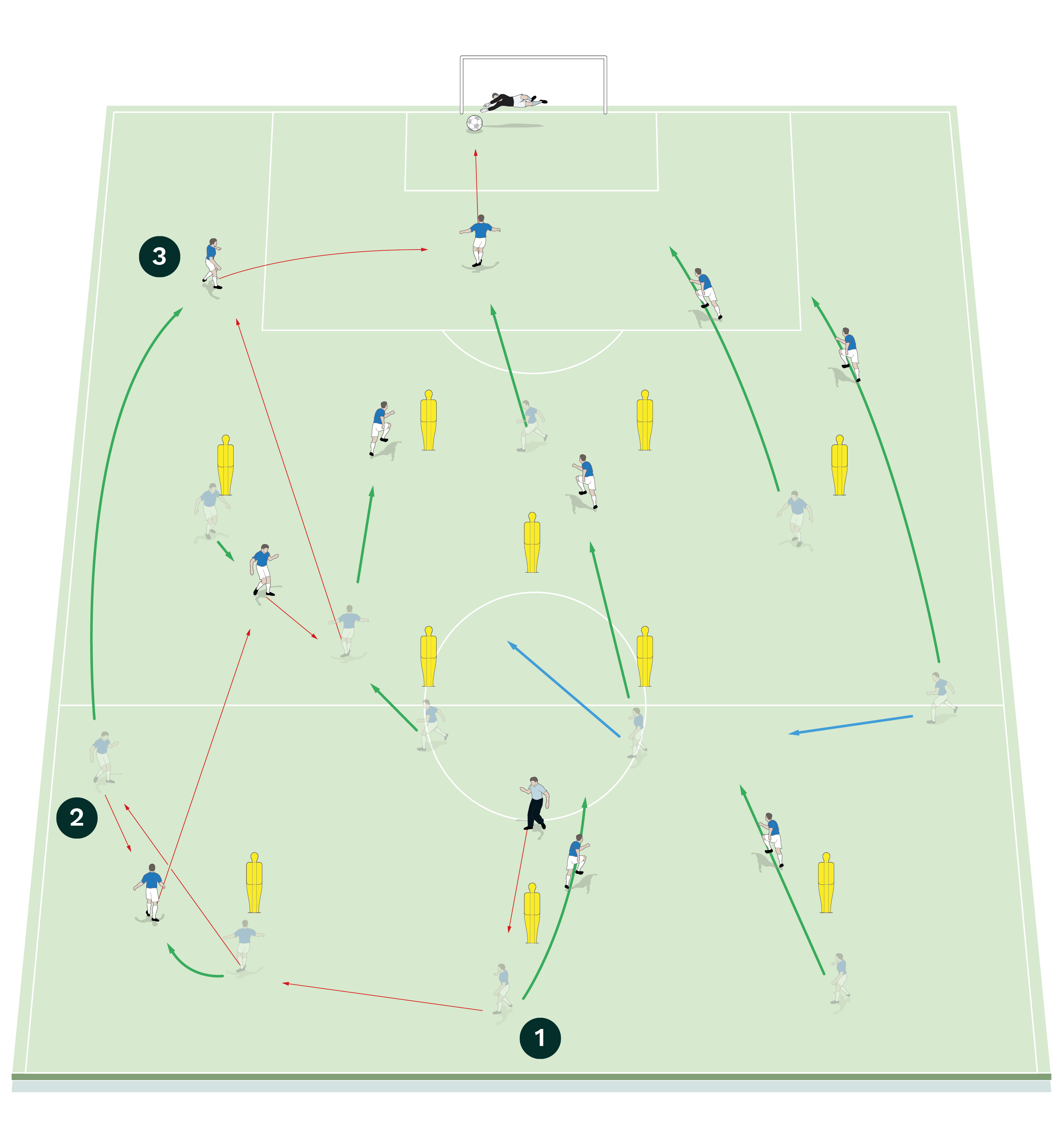
2. This time when the ball is passed to the left wing back, the wing back sets it back to the left centre back, who passes forward to the left- sided attacker
3. The players should combine to build up play through the middle third before the left wing back crosses into the penalty box
ATTACKING PATTERN 3
[4]
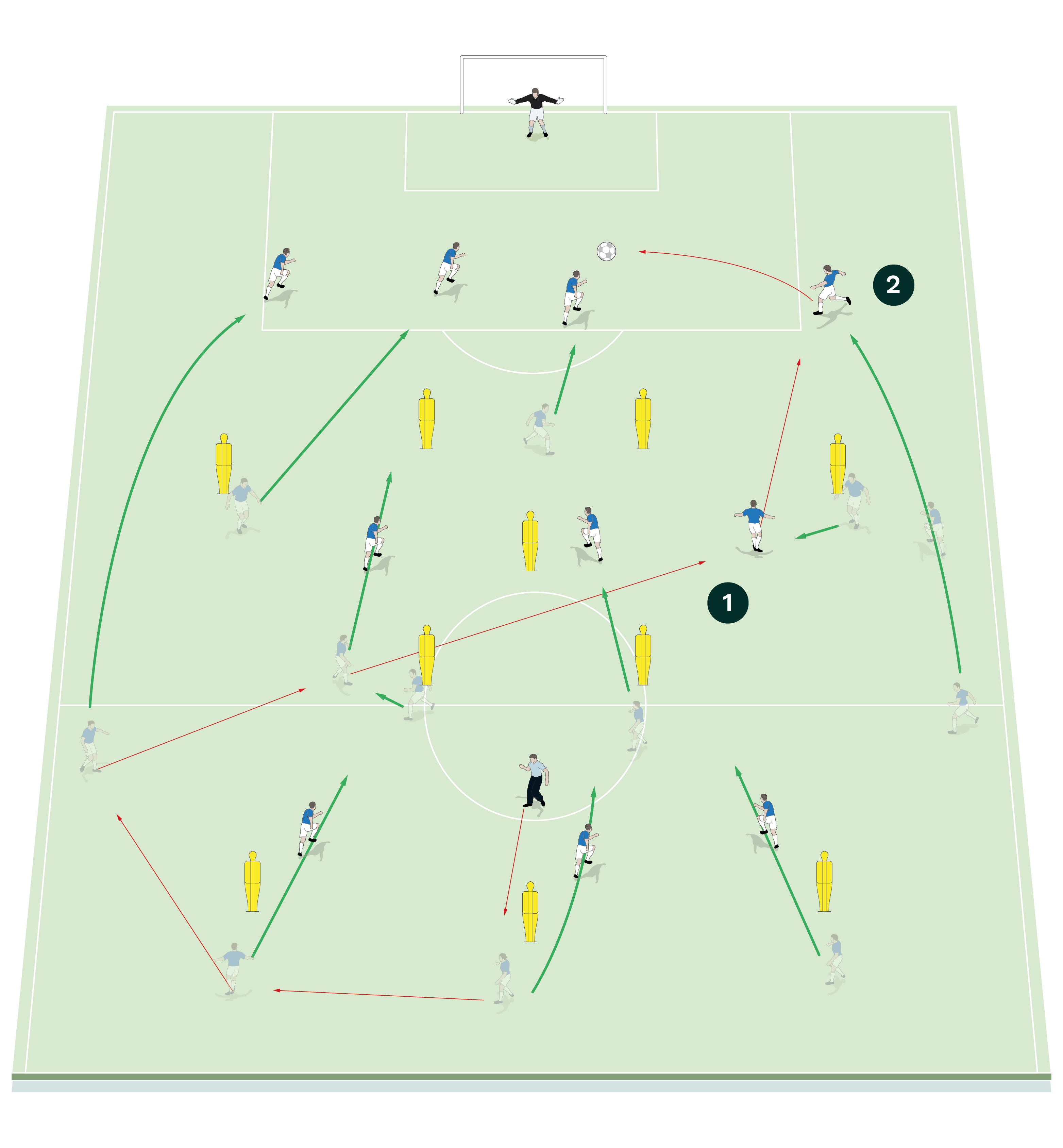
2. The wing back should make a well-timed run to receive and cross into the penalty box
“In this variation of the build-up, we want to see the midfielder showing good awareness over his shoulder to switch the play”
Using the same set-up, we work on yet another variation of the build-up play. Again the drill starts with the coach serving the ball to the middle central defender, but this time when the ball is worked to the left wing back, the ball is moved back across the pitch through the midfield, with the left-sided midfielder turning to switch the play with a diagonal pass to the right sided attacker. The right-sided attacker receives and turns to play a pass to the overlapping right wing back, who crosses into the box, as shown [4]. We would then run this drill going down the other side of the pitch.
In this variation, we want to see the midfielder showing good awareness over his shoulder to safely switch the play. We also want to see the wing back making a well-timed run to receive and cross.
We would finish the session by going into an 11v11 game on a full size pitch, allowing the players make their own decisions and play what they see.
Related Files
Editor's Picks
Using the goalkeeper in build-up play
Pressing principles
Intensive boxes drill with goals
Penetrating the final third
Creating and finishing
My philosophy
Pressing initiation
Compact team movement
Defensive organisation
Coaches' Testimonials

Alan Pardew

Arsène Wenger

Brendan Rodgers

Carlos Carvalhal

José Mourinho

Jürgen Klopp

Pep Guardiola

Roy Hodgson

Sir Alex Ferguson

Steven Gerrard
Coaches' Testimonials

Gerald Kearney, Downtown Las Vegas Soccer Club

Paul Butler, Florida, USA

Rick Shields, Springboro, USA

Tony Green, Pierrefonds Titans, Quebec, Canada
Join the world's leading coaches and managers and discover for yourself one of the best kept secrets in coaching. No other training tool on the planet is written or read by the calibre of names you’ll find in Elite Soccer.
In a recent survey 92% of subscribers said Elite Soccer makes them more confident, 89% said it makes them a more effective coach and 91% said it makes them more inspired.
Get Monthly Inspiration
All the latest techniques and approaches
Since 2010 Elite Soccer has given subscribers exclusive insight into the training ground practices of the world’s best coaches. Published in partnership with the League Managers Association we have unparalleled access to the leading lights in the English leagues, as well as a host of international managers.
Elite Soccer exclusively features sessions written by the coaches themselves. There are no observed sessions and no sessions “in the style of”, just first-hand advice delivered direct to you from the coach.
